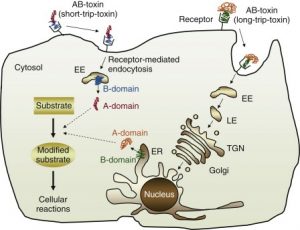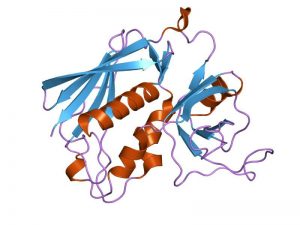▶Exotoxins
- The presence of a large number of microbes do not cause any disease but they maybe block the vessel, heart or passage in lungs etc.
- But normally pathogen produces a variety of molecule which cause pathogenesis like toxins.
- Exotoxins are protein released extracellularly as the organisms grow.
- These toxins move to attach a distance place from the place of infection.
- Exotoxins are synthesized by specific bacteria contain plasmid or prophages as bearing exotoxins gene.
- They are heat level proteins and inactivated at 60 degree Celsius to 80 degree Celsius.
- Exotoxins are easily inactivated by formaldehyde, iodine and other chemicals.
- Exotoxins are named by the disease.
- Most exotoxins belong to three categories:-
▶Cytolytic toxins:-
- Work by enzymatically attack the cell organelles causing lysis.
▶A-B toxins:-
- Consists of two covalently bonded subunits a and b.
- The b subunit bind to host cell surface receptor allowing the transfer of a subunit to the host cell and damage the host cell.
▶Superantigen toxin:-
- This works by simulating a large number of immune response cell resulting massive inflammatory reaction.
▶Cytolytic toxins:-
- They are also known as membrane disrupting exotoxins.
- They disrupt the integrity of the plasma membrane.
- They are of two types:-
- the toxin binds to cholesterol:-
- It is a protein that binds to cholesterol which is a part of the host plasma membrane insert itself into the membrane by forming a channel.
- This cause the cytoplasmic contents to leak out.
- Because the concentration of cytoplasm is more than extracellular fluid so water comes into the cell causing swelling and rupture.
- As an example, some pathogen produces membrane disrupting toxins which kill the phagocytic leukocytes.
- They are called leukocidin.
- Mostly produced by pneumococci streptococci and staphylococci.
- Because the pathogens destroy leukocytes the host resistance decrease.
▶Streptolysin-(SLO)
- It’s a hemolysin produced by streptococcus.
- SLO gets inactivated by O2 so the name was given O(SLO).
- When they are grown on blood agar and incubated anaerobically a complete clear zone called beta hemolysis.
- Fan partial clearing of blood is visible it is called Alpha hemolysis.
▶Streptolysin(SLS):-
- It is a hemolysin produced by streptococcus which is O2 stable so the name is given as SLS.
- They cause beta hemolysis on an anaerobically grown plate.
- Hemolysin attack plasma membrane of many cells not only erythrocytes and leukocytes.
▶A-B exotoxins:-
- They are composed of enzymatic subunits.
- There are two subunits first one is A which is responsible for the toxic effect when inside the host cell.
- The second one is B which is known for binding subunit.
- A is enzymatically active but do not have binding and entry capacity.
- B can bind to target cell but non-toxic and biologically inactive.
- B subunit interacts with a specific receptor on the target cell or tissue.
Mechanism:-
- B subunit inserts into PM and creates a poll for ‘a’ subunit to enter.
- Another mechanism is receptor-mediated endocytosis.
- Interceptor mediated endocytosis the B subunit binds to surface receptor P is taken into the cell through clathrin-coated vesicles.
- The toxin then enters the vesicle membrane and cleaved into two parts.
- From that, a move to cytosol which is an enzyme catalyzes the addition of an EDP ribose group to elongation factor 2 required in translocation.
- This modified elongation factor 2 protein can’t participate in the elongation cycle of protein synthesis.•so the cell dies without protein synthesis.

Affect the nervous system and also indirectly cause the enteric symptom. Neurotoxin:-
- Example staphylococcal enterotoxin B
- True enterotoxin has defect effect on intestinal mucosa by profuse fluid secretion.
- B subunit made of five parts arranged in a dough shaped ring.
- B subunit anchor itself to the p.m. and insert the smaller a subunits into the cell.
- A subunit activates tissue adenylate cyclase to increase intestinal cycle an AMP concentration.
- High cyclic amp concentration Max the movement of massive quantities of water and electrolyte from the cell to lumen or gut.
- Example – vibrio Cholera
▶Exotoxins in disease:-
- A human exposed to bacteria in three main ways:-
- Injection of exotoxins -staphylococcus occurs self-limiting
- Colonization on the mucous membrane and produce exotoxin cause disease at distance place-vibrio Cholera
- Colonization of a wound then local exotoxins production cause local tissue damage or kill the phagocytic cell which enters the infected area-clostridium perfringens.

